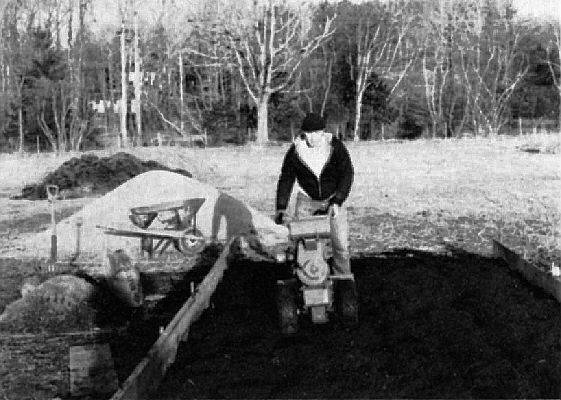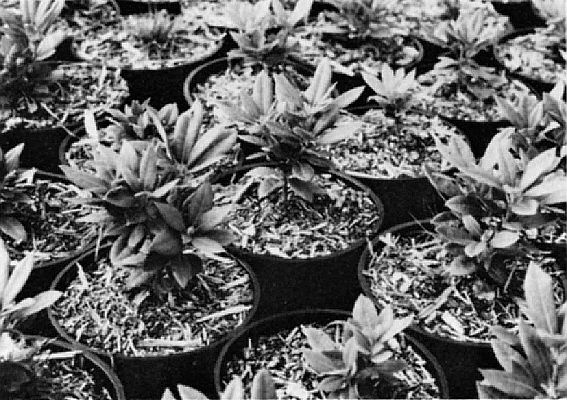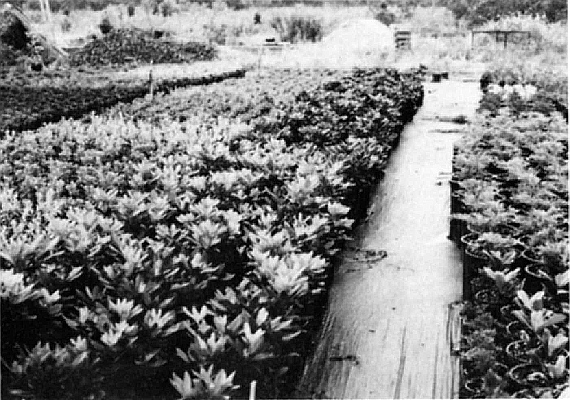Growing Ericaceous Plants in Soilless Mediums
Stephen P. Feryok and Charles Feryok, Grace Nursery
Hopewell, New Jersey
Due to the skyrocketing cost of shipping and the scarcity of local material, we as small nurserymen have had to experiment with new media of soilless mixes in our container growing operation. The two types of soilless mediums we have used are hardwood and pine barks.
Although hardwood bark is easier to obtain in our area, it takes more time to learn how to work; however, once a system is obtained the results can be quite good. It is best to age hardwood bark as long as possible. Six weeks is the minimum time required for composting. We start composting as soon as possible, usually in the fall. Composting is done by adding five pounds of ammonium nitrate and two pounds of tri-superphosphate per yard of bark. To get a uniform mix of these ingredients, we build a wooden frame big enough to work five yards of bark at a time. The bark is loaded onto the frame and spread out until a uniform depth of approximately six to eight inches is obtained. A rototiller is then run through each batch until the bark is completely mixed. This depth was chosen because when the bark was six to eight inches deep the rototiller blades were just able to touch the bottom of the frame, insuring a good blending of our mixture.
A few more steps are needed before the hardwood bark is ready to use. As each batch of bark is removed from the platform frame, it should be stockpiled in windrows approximately four feet high. One of the most important concepts to remember when composting bark is that the more air that is supplied to the bark the faster the bacteria can break it down. If not enough air is supplied, the bacteria will die and the media will sour and therefore be rendered useless. This problem can be overcome by turning the pile of bark over once or twice. Another method of supplying air to the piled bark is to lay drainage pipe under the bark before it is stockpiled.
After the proper period of time has elapsed for decomposition, the bark is reloaded onto the frame. This time a coarse sand such as concrete sand is added to the mixture. Add four yards of bark to one yard of sand. The sand could have been added when we were preparing the bark for decomposition which would have made the pile more porous, but sand tends to leach to the bottom of a standing pile. It is a matter of choice as to when one would want to add the sand. Finally, a slow release fertilizer is added to the mixture at the rate of five pounds per yard. Hardwood bark contains a high amount of calcium and therefore has a high pH value. We have had to use as much as two pounds of pelleted sulphur per yard of bark to stabilize the mixture. Because it is a soilless medium, it is necessary to also add a pound of micronutrients and, finally, one pound of wetting agent per yard of bark is added. Although hardwood bark has good retention capacity, adding the wetting agent now will enable the medium inside the container to get evenly moist. This will enable you to cut down on the amount of water that will be needed later to saturate the container.
Pine bark, which is shipped from the south has several advantages over hardwood bark. It does not need composting, so it can be used almost immediately. How quickly it can be used depends on the grade of the bark. If the nuggets are too large the bark may need to be screened. We used a wood shredder to get the maximum use of the bark. The same wood frame method for mixing as described above for hardwood barks was used on the pine bark. The ratio of sand to bark is the same, four parts bark to one part sand. To obtain the best results when mixing spread the sand evenly on the top of the bark. Do not dump it all in one area and then try to mix. Add to the pine bark five pounds of slow release fertilizer, one pound of micronutrients, five to seven pounds of limestone and one pound per yard of dry wetting agent, mix thoroughly with the rototiller.

|
| Mixing with rototiller |
The system that we have described for the processing of pine and hardwood bark is relatively simple and economical. Paying attention to technique in processing the barks is the key to the whole operation. We have grown many ericaceous plants in both mediums with satisfactory results. For those growers who do not use containers, these soilless mixes are 'quiet good in raised beds. The obvious advantage is the ability to grow plants like the rhododendrons in areas where the soil does not lend itself easily to the growth of ericaceous plants.

|

|
|
Rhododendron 'Lee's Best Purple' grown in
hardwood bark, one growing season from cutting. |
Two year old plants, all growing in hardwood
and pine bark media |
Which bark is best? There is no clear cut answer to this question. Each has its own advantages, depending on where you live and the availability of pine or hardwood bark. So the bark that you may choose to use will be a function of the amount of money that you can spend and the time you have to invest in its preparation.